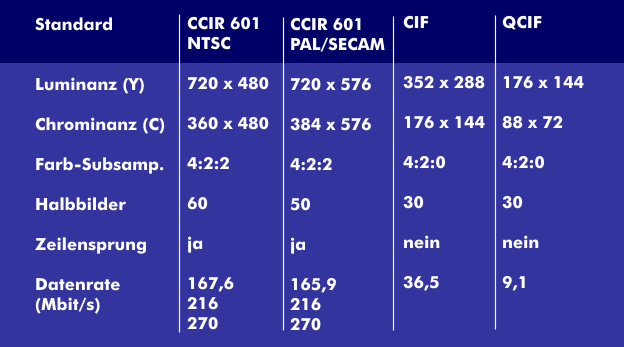ITU-R BT.601
The file format for interlaceddigital video, as known from NTSC and the PAL television standard, was first specified by CCIR under CCIR-601, and later by the International Telecommunication Union( ITU) under the ITU-R BT.601 standard. BT.601 describes the conversion between YCbCr and RGB of analog television signals with frame rates of 50 Hz and 60 Hz and line frequencies of 15.625 kHz and 15.750 kHz, as used in the PAL television standard and in NTSC. While BT.601 is mainly used for Standard Definition Television( SDTV) and DVDs, BT.709 is concerned with HDTV, HD-DVDs as well as Blu-Ray discs.
The BT.601 file format specifies a sampling frequency of 13.5 MHz. This results in a total of 864 pixels for the PAL standard with a line length of 64 µs, of which 720 pixels are visible. NTSC also has 720 visible pixels, although it has 858 samples per line. Vertically , the display has 576 visible pixels (PAL) and 486 for NTSC. The horizontal and vertical pixel values are used to calculate the aspect ratio of the pixels, which are not square, but have an aspect ratio of 1.0667 from pixel width to height in the PAL standard with an image display of 4:3. In anamorphic widescreen with 16:9 display, the pixels become more rectangular with a ratio of 1.422 (PAL).
Furthermore, BT.601 specifies that the chrominance signals Cb and Cr are sampled from every second clock, i.e. with a color subsampling of 4:2:2. The color depth is 8 bits or 10 bits, corresponding to the Standard Dynamic Range( SDR) used in classic studio technology. The frame rate is 25 full frames per second (PAL). The resulting data rate is 216 Mbit/s for an 8-bit color depth and 270 Mbit/s for a 10-bit color depth. The data stream, the format of which is specified in BT.656, results from the sampling rate of 13.5 MHz multiplied by the color depth of 8 bits for the luminance signal and the sampling rate of 13.5/2 MHz of a color depth of 8 bits for both the Cb signal and the Cr signal. The individual components of the BT.601 data stream can be transmitted in parallel over several lines as "Y", Cb and Cr, but they can also be transmitted at 27 MHz in time-division multiplex in the sequence Cb,Y,Cr,Y,Cb,Y,Cr...and so on.
The actual image area is limited in BT.601 in that the black level does not start until digital level 16 and the white levelstarts at digital level 235. If one calculates with this specified brightness range, one arrives at a data rate of 165.9 Mbit/s.
In the PAL standard, the visible lines begin 132 samples after the start of the corresponding analog sync pulse and end 12 samples before the next sync pulse.


